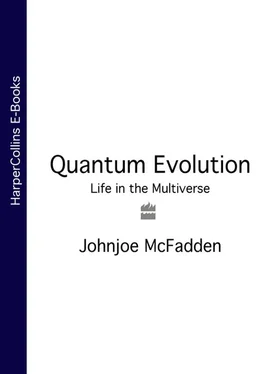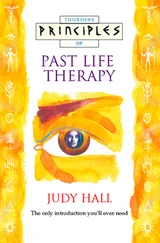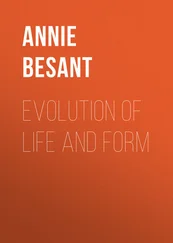It would be mistaken to equate Aristotle’s eidos too closely with the Christian soul. He believed all animals and plants were endowed with a ‘soul’ capable of initiating movement. To Aristotle, this soul was clearly a much more functional entity than the Christian moral guardian. However, only man possessed the highest form of soul: the source of reasoning and moral judgement.
Aristotle’s writings, lost and then found by the Arabs and passed from them to mediaeval Europe, were to form the basis of Western thinking throughout the Middle Ages. The Aristotelian concept of a soul was translated into the vitalist approach to biology. To the vitalists, life possessed a mysterious property, the élan vital , or living spirit, whose nature lay beyond the realms of science. In the words of Joyce Kilmer:
Poems are made by fools like me
But only God can make a tree.
The vitalist tradition survived until the twentieth century in many biological writings. I remember biology textbooks that described the mysterious living protoplasm inside cells with the same awe and mystery that mystics describe the aura. However, the concept has been in retreat since the dawn of the Age of Reason in the seventeenth and eighteenth centuries, and no serious scientist subscribes to it today. The opposing camp, the Mechanists, were inspired by the machines that were, by then, revolutionizing the world; and they believed that life, like machines, could be understood in terms of the laws of chemistry and physics. They rejected the vitalist argument that life required special laws beyond conventional science. René Descartes (1596–1650) was a founding figure who proposed that animals were mere automata, in principle no different from the clockwork figures which played music or danced at fairgrounds. Descartes was however unwilling to accept the full implications of mechanism and reserved man a special place amongst God’s creations. He considered man’s intellectual capabilities, his reasoning power, betrayed the presence of an immortal soul. Mechanists had to wait for another century before books such as La Mettrie’s L’Homme Machine (Man the Machine) (1748) laid bare the full force of the mechanist manifesto. La Mettrie agreed that animals were no different from machines but argued that man differed from animals only in complexity. The way was now open for science to delve into the very substance of life.
Technical advances in analytical chemistry and microscopy naturally drove the life sciences towards reductionism – the belief that complex systems can be considered as the sum of their parts. Nineteenth- and twentieth-century scientists began a reductionist dissection of the chemistry of life. In 1853, the Lille brewing industry hired Louis Pasteur to discover why their wines soured. At that time, fermentation was considered purely a chemical reaction. Brewer’s yeast was thought to be a chemical catalyst facilitating the conversion of the grape-sugars to alcohol: yeast was not recognized as a living organism (which is not so strange when you examine it in its powdery form). The brewers’ hiring of the brilliant young chemist was, thus, hardly surprising.
Pasteur had made his name demonstrating that tartaric acid crystals came in two forms, left- and right-handed that were mirror images of each other. When he synthesized tartaric acid in the laboratory he grew crystals with approximately equal proportions of the left- and right-handed forms. However, when he extracted tartaric acid from living tissue, the crystals he grew were always left-handed. Pasteur found that the same was true for nearly all biochemicals extracted from living tissue: if the chemical came in a left- and right-handed form, then only one would be found in living tissue. Living systems were chiral. He was therefore astonished to find that growing crystals out of wine fermentations, he obtained only left-handed crystals. This convinced Pasteur that he was dealing with a biological process rather than a simple chemical reaction. He confirmed his suspicions by demonstrating that yeast was a living microbe that fed on sugar, generating both alcohol and (sour) acids as the waste products. He thereby discovered the cause of the souring in brewing, and simultaneously founded the sciences of microbiology and biochemistry.
This marriage of mechanist philosophy and reductionism led to the great triumphs of twentieth-century biology. Over many decades, the myriad of interlocking biochemical pathways forming the living cell’s metabolic skeleton were laid bare. This knowledge and capability has led to major innovations in medicine and biotechnology. It may seem churlish to question the success of the mechanist/reductionist approach. Yet, despite its undoubted success in elucidating the chemical processes that underscore life, has it really enabled us to understand life itself? It is noteworthy that several centuries since the mechanist manifestos of Descartes or La Mettrie claimed that living organisms were mere machines, we have not succeeded, despite numerous attempts, synthesizing life in the laboratory. Joyce Kilmer’s line still hold true. No one has ever made a tree, or a flower or an animal or an insect or even the lowliest bacterium. 7The sole means of making life is procreation – sowing the seeds of pre-existing life forms. Though scientists can confidently describe physical chemical reactions taking place at the centre of our sun, at the surface of black holes, or during the first millisecond of the universe’s existence they cannot achieve what the lowliest life forms on Earth manage with ease: make life.
Our failure to put the ingredients of life together and obtain anything living suggests something must be missing from our list. Perhaps we should start by examining why the mechanist/reductionist approach has failed to tackle life’s fundamental questions: there is a paradox that lies at the heart of the reductionist approach to biology. As one dissects the workings of any living creature, examining the detail of smaller and smaller components (we will be attempting to do just this in the following chapters), life itself seems to vanish before our eyes. Whilst we have no difficulty in recognizing life in a whole animal, or indeed in one of its cells; when we come to looking at the cell’s insides, the question seems to evaporate. Is a chromosome alive? What about a gene or DNA? Is a ribosome alive, or a protein or an enzyme? The question seems to lose its relevance when applied to these bits of life. The components of living cells, stripped of context, seem fundamentally no different to inanimate chemical systems. Life seems to emerge only at higher levels. It is, to use modern jargon, an ‘emergent’ phenomenon: one that cannot be entirely understood in terms of its parts. As a means to explaining life, the unrelenting reductionist approach is doomed to failure.
There are of course many phenomena, both biological and non-biological, that do not succumb to what the philosopher Daniel Dennett describes as ‘greedy reductionism’ – the mating behaviour of birds, ecology or politics – to name but a few. Each has its appropriate level of explanation and no one would attempt to analyse them at the level of fundamental particles. However, that life itself is such a phenomenon, whose appropriate level of explanation lies at cells or above, is not generally appreciated. But if we cannot hope to understand life by dissecting it, what alternative approach can we use? We should start by looking again at what we are studying. What is life? We still have not answered the question that troubled our ancestors thousands of years ago. The modern answers have suffered the fate of reductionism. Life is reduced to a collection of parts which, in isolation, have lost their essential livingness. Attempts by scientists and philosophers to identify the key properties of life read rather like a checklist: self-replication, sensitivity, evolution, heredity, metabolism, etc. etc. If you can tick more than three boxes then it’s probably alive; but in isolation none is either necessary or sufficient to define life. Consider self-replication. This is generally considered to be a key attribute of living organisms. But not all organisms that appear to be alive are capable of self-replication. No mule has ever produced offspring. Many of the hybrid varieties of garden plants are sterile. Even when we examine life at a cellular level there are many cell types (for instance, nerve cells) which are certainly alive but are unable to replicate. The same kind of arguments can be used with any of the properties said to define life. They all somehow miss the key feature.
Читать дальше












